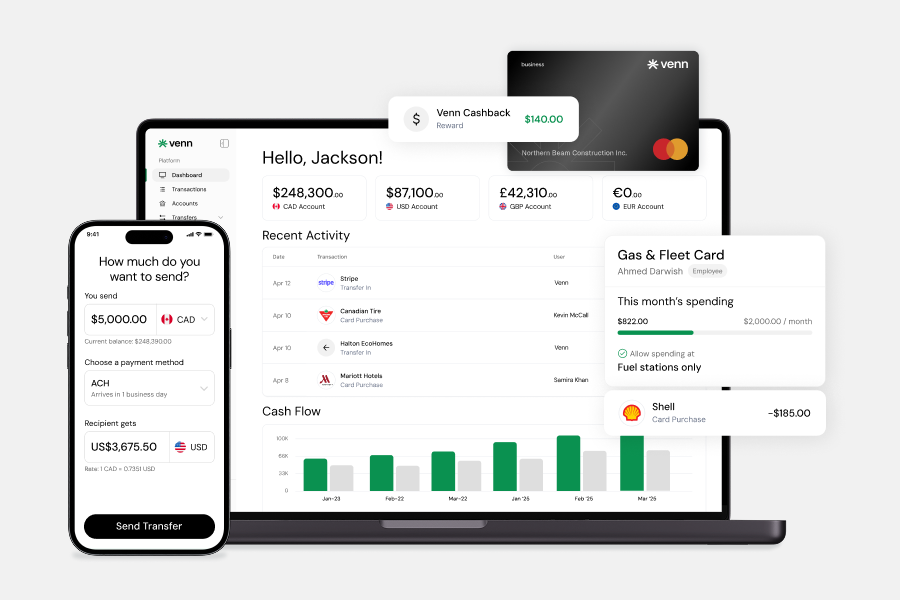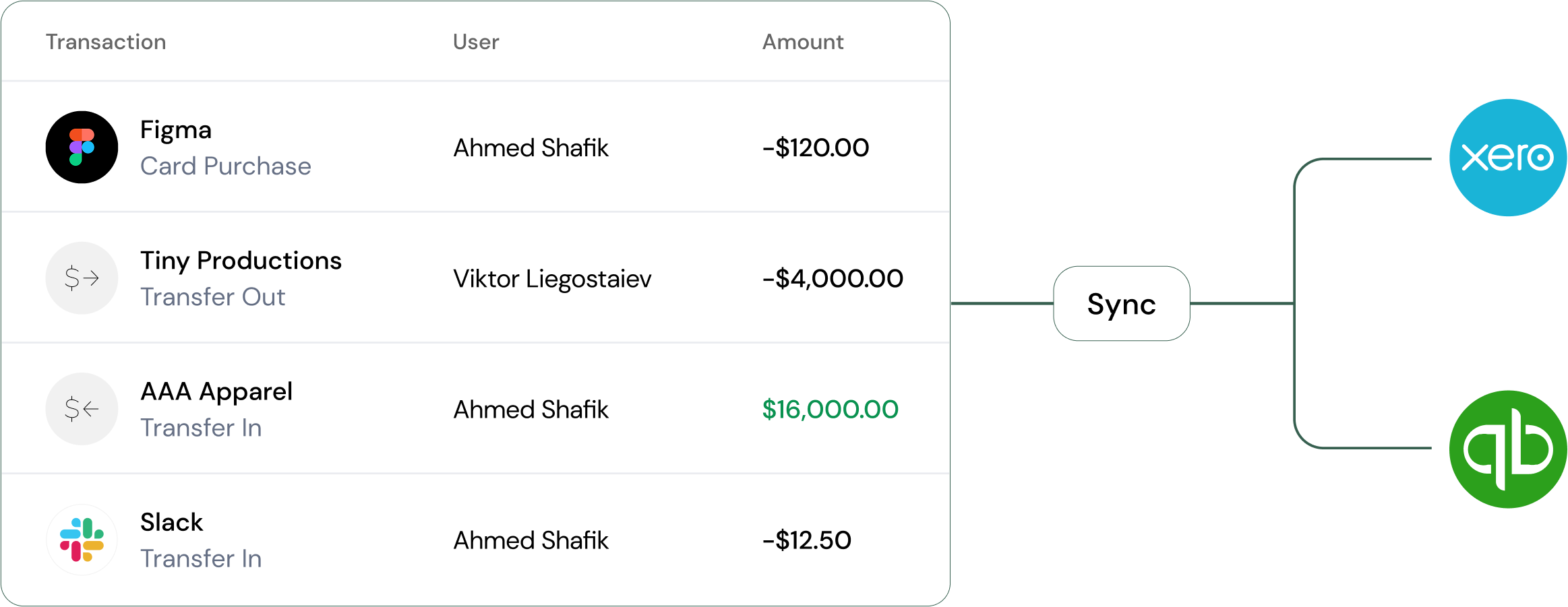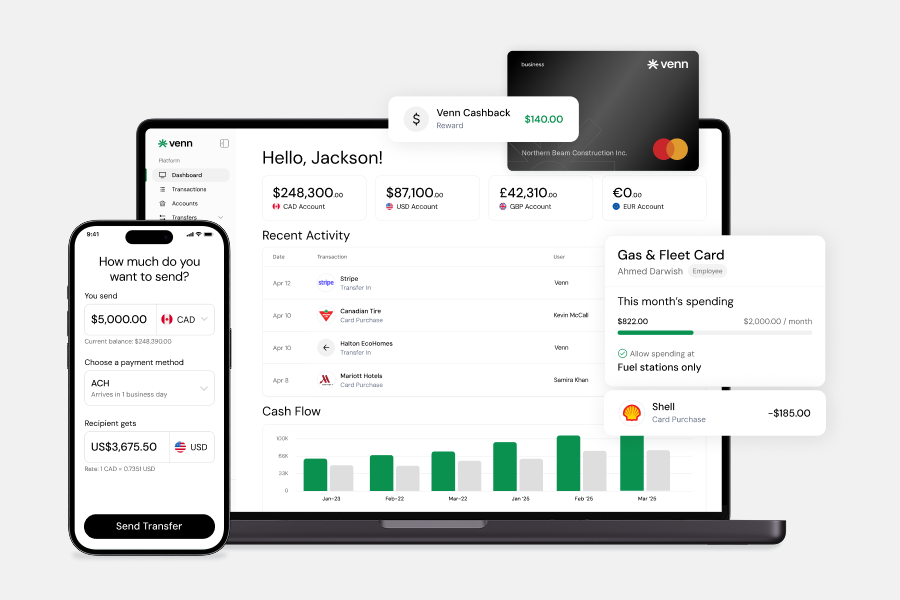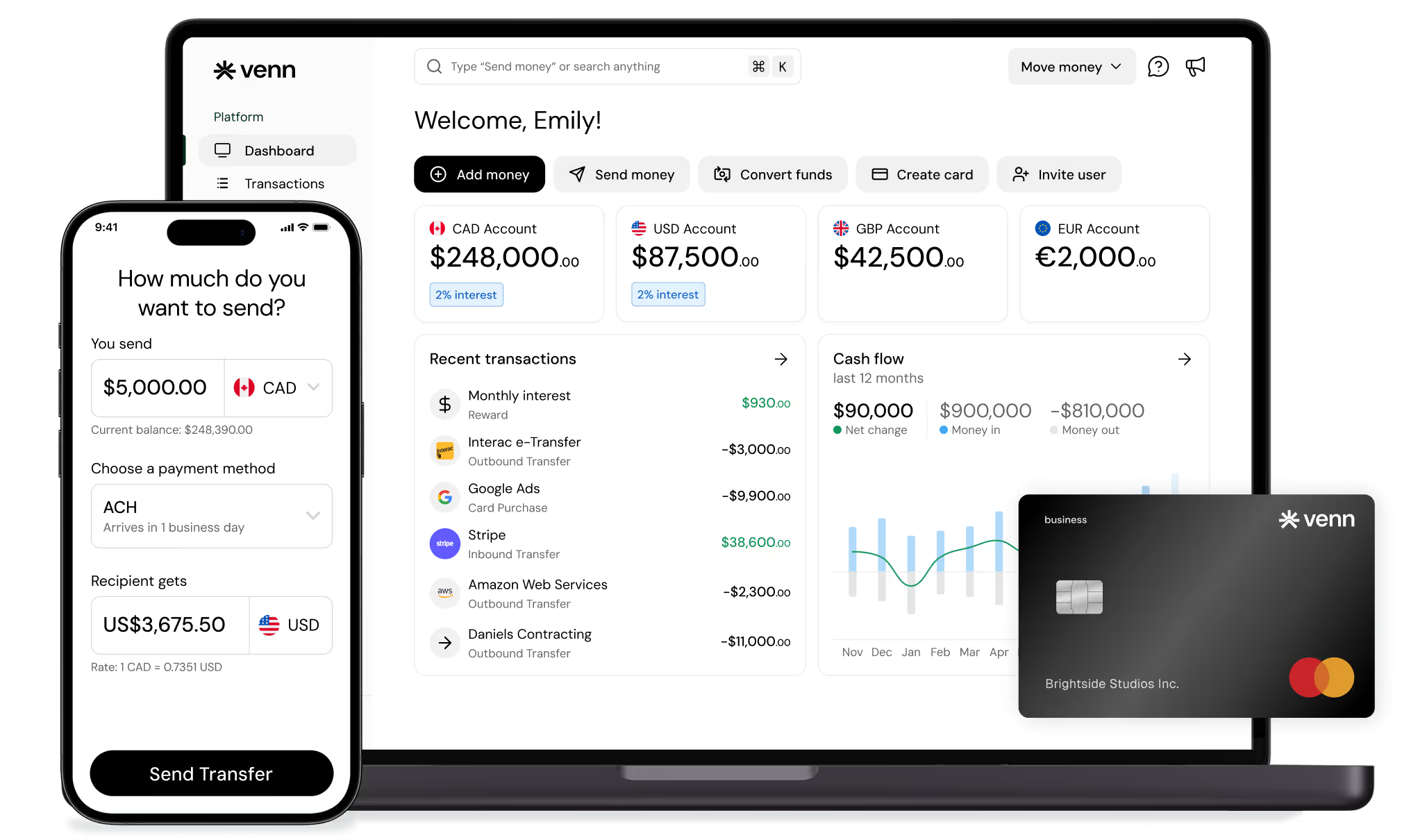What are General and Administrative (G&A) Expenses?
Most businesses treat G&A like a catch-all. This guide shows you how to clean it up, stay compliant with CRA rules, and keep overhead under control for good.
%20expenses%20blog%20thumbnail.png)

Trusted by 5,000+ Canadian businesses
Business banking for Canada
Local CAD and USD accounts, corporate cards with cashback, the lowest FX rates in Canada, free local transfers, and more.
General and administrative (G&A) expenses are the ongoing costs that keep your company running, even when sales fluctuate. They include rent, utilities, insurance, accounting, and administrative salaries, which are the essentials that keep the business operating. Managing them affects your margins, compliance, and how quickly you close the books.
We'll explain what qualifies as G&A, what doesn't, how GST/HST input tax credits work, and how to control costs while staying CRA compliant.
Understanding G&A expenses in Canada
A business expense is deductible if it is reasonable, incurred to earn business income, and properly documented. “Reasonable” means the cost aligns with your business size and industry; for example, a modest phone plan for a solo consultant may be fine, while a $600 plan might not be.
Typical G&A expenses include:
- Office rent and utilities
- Office supplies and company-wide software subscriptions
- Professional fees such as legal and accounting
- Salaries and benefits for administrative staff and management not directly tied to sales or production
- Insurance premiums related to operations
- Business licences and professional dues (excluding recreation or club fees)
CRA confirms that most ordinary business expenses are deductible if they meet the “reasonable and incurred to earn income” test. Club or recreational dues are specifically excluded.
In short, if an expense keeps your business running but doesn’t directly generate revenue, it likely falls under G&A.
What is not G&A?
Just as important as knowing what goes into G&A is knowing what doesn’t.
- COGS (Cost of Goods Sold): Direct materials, direct labour, and shipping related to producing goods or services.
- Selling expenses: Advertising, sales commissions, sponsorships, and sales travel. These belong in Selling, not G&A.
- Capital assets: Computers, machinery, and furniture are capitalized and depreciated using Capital Cost Allowance (CCA) instead of being expensed in the same year.
G&A vs. SG&A
SG&A (Selling, General and Administrative) includes all operating costs that aren’t part of cost of goods sold. Many small businesses report a single SG&A line, but separating Selling from G&A gives you more control and clarity.
Doing so helps you:
- Track which costs scale with revenue and which do not
- Hold departments accountable for their budgets
- Spot efficiency gaps before quarter-end

Keeping G&A separate helps you see which costs scale with growth and which stay fixed, making budgets and forecasts more accurate.
GST/HST registration and input tax credits
When your business must register for GST/HST
The small-supplier threshold for most businesses is $30,000 CAD in taxable sales (before expenses) over a single calendar quarter or over the last four consecutive quarters.
- If you exceed $30,000 in one quarter, you cease to be a small supplier immediately, and your effective date of registration is no later than the day of that supply.
- If you exceed $30,000 cumulatively over four quarters, your effective date is the day after you cease being a small supplier.
- You must apply for registration within 29 days of that effective date.
- Public service bodies such as charities and nonprofits have a higher $50,000 threshold.
For more detail, see the official CRA guide on when to register for GST/HST.
If you’re ready to register, follow our step-by-step breakdown on how to register for a GST/HST number in Canada.
Claiming input tax credits (ITCs)
Input tax credits (ITCs) let your business recover the GST/HST paid on eligible purchases. Once registered, you can deduct these credits from the amount you owe the CRA.
To stay organized, you'll need a clear system for categorizing expenses. Accountants call this the chart of accounts: a list of categories you use in your books to record every transaction. When set up properly, it makes your financial reports and tax filings easier to manage.
For small and medium-sized businesses, you only need three broad categories to stay organized:
1. General and Administrative (G&A)
These are your everyday operating costs that keep the business running. Think of rent, utilities, office supplies, accounting or legal services, and salaries for admin and finance staff. They are the backbone of your operations but do not directly produce sales.
2. Selling and Marketing
This category covers anything tied to generating revenue. That includes advertising, promotional costs, sales commissions, and travel for client work. Keeping these separate from G&A helps you see how much it costs to bring in new business versus how much it costs to run the business.
3. Capital Assets
Some purchases, such as computers, furniture, or machinery, are not day-to-day expenses. They are long-term investments that lose value gradually over time. These go on your balance sheet instead of your expense list and are written off through Capital Cost Allowance (CCA) under CRA rules.
Keeping these three sections clear helps you manage overhead, forecast more accurately, and make decisions about spending. When everything falls into the right category, your reports show a true picture of where money is going and where efficiencies can be found.
How to put this in place quickly
Once you understand how your expenses should be grouped, setting up your categories is straightforward. You can do it in under an hour.
Start by cleaning up your accounting software. The goal is clarity, not complexity.
- Rename categories so they are clear and self-explanatory.
- Remove duplicates so there is only one logical place to record each expense.
- Add short descriptions for each main category. For example, “Software: companywide tools only. Sales tools go to Selling.”
- Assign default categories to common vendors to reduce miscoded entries and speed up reconciliation.
If you already use QuickBooks or Xero, Venn connects directly to both with two-way accounting sync. When you pay bills or capture receipts through Venn, transactions automatically post to your accounting system in the right category, removing manual work and improving month-end accuracy.
This simple structure is enough to make your financial data easier to read, your G&A analysis cleaner, and your close process faster.

Documentation: what CRA expects
Keep invoices and vouchers that support the business purpose, vendor, date, and amounts. Digital copies are acceptable when they are legible and accessible. The Government of Canada’s business expense pages outline documentation expectations and common categories.
Common expense edge cases for Canadian businesses
Companywide software: Tools used across the company, such as HRIS or finance platforms, are usually G&A. Sales-specific tools belong in Selling.
Meals and events: Prospect-facing meals are Selling. Internal team meals and operations offsites are typically G&A. Observe CRA deductibility limits and keep itemized receipts.
Home office and remote work: If you use part of your home as your main place of business or regularly meet clients there, you can deduct a reasonable portion of home expenses. CRA provides the formula for calculating the deductible portion.
Laptops and equipment: Treat these as capital assets and claim CCA over time instead of expensing them. CRA outlines the process for calculating depreciation and capital classes.
Practical ways to keep G&A lean
1. Standardize vendors and terms
Consolidate overlapping tools and negotiate annual terms only where usage is stable. Avoid prepaying for seats that may change.
2. Set guardrails on spend
Issue corporate cards with category controls, per-user or per-team limits, and real-time tracking. Stopping out-of-policy spend before it hits the ledger is more efficient than cleaning it up later.
3. Route payments intelligently
Use low-cost domestic rails for routine vendor payouts and payroll. Pay US vendors by ACH from a true USD account to avoid cross-border fees and double conversion. Reserve wires for urgent or unusual corridors. Here's a closer look at how ACH and EFT payments compare.
4. Automate the close
Use receipt capture, coding rules, and approvals so transactions land in the right accounts the first time. Sync with your general ledger to cut back-and-forth during month-end.
Track a small set of KPIs
- G&A as a percentage of revenue
- G&A per full-time equivalent
- Professional fees by project or matter
- Companywide software spend per FTE
- Review monthly against budget and highlight variances early.
How Venn simplifies G&A management
Venn is a business banking platform for Canadian companies. It brings invoicing, payments, multi-currency accounts, and FX transfers into one place, which helps you control SG&A while keeping operations smooth.
- Invoicing and receivables: Create invoices and reconcile payments faster.
- Payments and payables: Pay vendors by low-cost domestic transfers and send global transfers online with clear FX.
- Multi-currency accounts and FX transfers: Hold CAD, USD, GBP, and EUR, and pay from the right currency to reduce FX losses hitting G&A.
G&A is easier to manage when the tools actually talk to each other. Venn connects your accounts, cards, and books in real time so you can see every dollar that moves, without spreadsheets or manual work.
You’ve built the business. Now build the systems to match. Start with Venn today!

Frequently asked questions (FAQ)
Q: How much G&A is normal for a small business?
The normal range for General and Administrative (G&A) expenses varies by industry and stage. For many service-based businesses, G&A typically falls between $\text{10}\%$ and $\text{25}\%$ of total expenses. The most important metric is the trend: if overhead costs grow faster than your revenue, it signals a need to review spend areas like software subscriptions, administrative salaries, and professional fees.
Q: How often should G&A categories be reviewed?
You should review your G&A categories at least once a year, ideally when preparing your annual budget or before your fiscal year-end. Categories should also be adjusted immediately when your business experiences a structural change, such as expanding into new markets, supporting multiple currencies, or adding new departments.
Q: Can I split an expense between G&A and another category?
Yes. If a single expense benefits multiple functions—for instance, an enterprise software subscription used by both the Finance (G&A) and Sales teams—you can allocate it proportionally. The critical requirement is to clearly document the reasoning for the split (e.g., allocation based on headcount or usage) and apply that allocation consistently throughout the fiscal year.
Q: What happens if I misclassify G&A expenses?
While the CRA rarely penalizes honest classification mistakes, incorrectly classifying G&A expenses distorts your financial reports. This makes forecasting inaccurate, undermines internal budget planning, and can raise red flags during an audit if expense treatment is inconsistent. Accuracy is key for effective financial decision-making.
Q: How can I lower G&A without cutting people or essential tools?
The most effective way to lower G&A is through automation and efficiency. Focus on removing manual work and unnecessary complexity: automate transaction reconciliation, implement simplified real-time approval workflows, and audit for redundant software subscriptions. Improving back-office efficiency often provides greater savings than simply cutting line items.
This publication is provided for general information purposes and does not constitute legal, tax or other professional advice from Venn Software Inc or its subsidiaries and its affiliates, and it is not intended as a substitute for obtaining advice from a financial advisor or any other professional. We make no representations, warranties or guarantees, whether expressed or implied, that the content in the publication is accurate, complete or up to date.
Venn is all-in-one business banking built for Canada
From free local CAD/USD accounts and team cards to the cheapest FX and global payments—Venn gives Canadian businesses everything they need to move money smarter. Join 5,000+ businesses today.

Frequently asked questions
Everything you need to know about the product and billing.
Venn is the cheapest and easiest way to manage your business banking needs. We offer the best currency exchange rates in Canada, chequing accounts in multiple currencies, domestic and international bank transfers, and a corporate Mastercard to manage all your spend. By signing up to Venn you automatically get:
- Accounts in Canadian dollars, US dollars, British pounds, and Euros
- The cheapest FX rates in Canada with free domestic transfers (EFT, ACH, SEPA, FPS)
- A Mastercard Corporate card that gets you the same great FX rates and cashback with no minimum spend requirements
Yes, Venn holds eligible deposits at our Partner Institution in our trust accounts, including deposits in foreign currencies. CDIC protects eligible deposits up to CA$100,000 per deposit category per CDIC member institution.
No, we don’t have any hidden fees! All charges, including currency conversion and premium plans, are clear and transparent. You can even issue unlimited corporate cards to your team and sign up with a free plan in minutes! Learn more about our transparent Pricing.
Nope! Other companies and traditional bank accounts have high minimum balance requirements. This makes accounts inaccessible for small businesses or individuals. Venn does not require a minimum balance. Your CAD and USD funds will also earn 2% interest regardless of the balance.
Our process is quick — Customers typically get set up in 5 minutes or less! Create a free account and start saving with no monthly fees, cashback on card spend, and the best FX rates around.
Of course! Our friendly Support specialists are available via Chat or Email 24 hours a day, 7 days a week, 365 days a year. All tickets are monitored and responded to within 24 hours, with an average response time of 30 minutes.
Yes, we have a direct integration with QBO and Xero. We are working on more integrations very soon!
Join 5,000+ businesses banking with Venn today
Streamline your business banking and save on your spend and transfers today
No personal credit check or guarantee.


